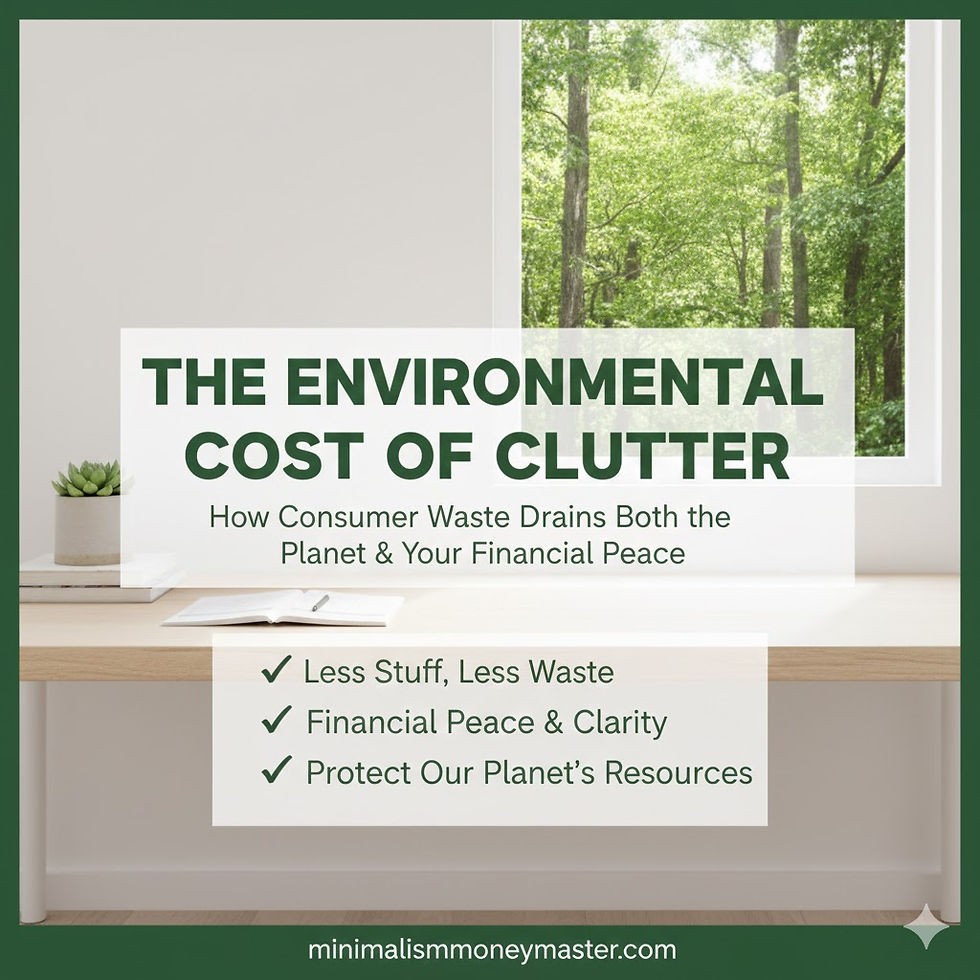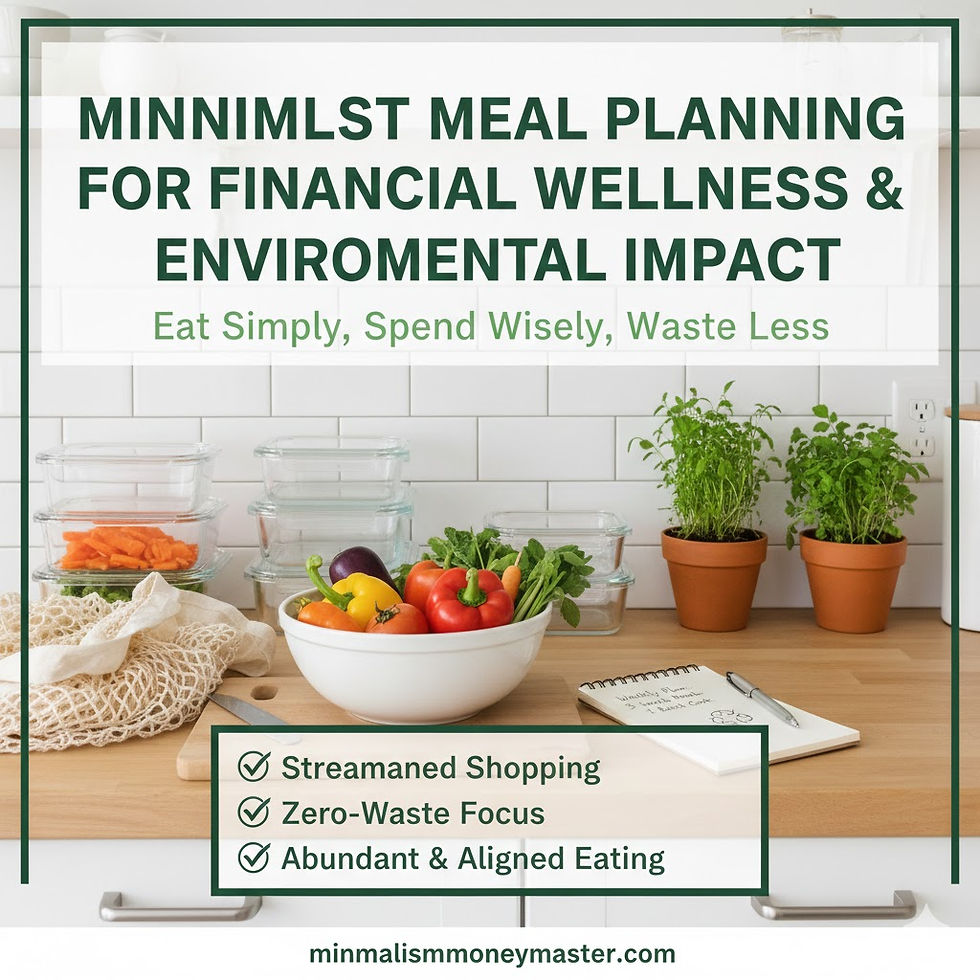Minimalist Futures: How Simplicity Will Reshape Work, Housing & Finance
- jennifercorkum
- Oct 20
- 5 min read
Minimalism is no longer just a personal lifestyle choice — it’s becoming an economic and cultural force. In Part 1 of this series, we explored how minimalism has evolved from decluttering to a global movement, accelerated by technology and shifting cultural values.
Now, let’s look forward. If the minimalist mindset continues to spread, what will our world look like in 10, 20, or even 50 years? How will work, housing, and financial systems adapt when simplicity becomes the default rather than the rebellion?
As someone who’s practiced financial minimalism for years, I’ve learned that simplicity doesn’t limit your options — it multiplies them. And when that mindset scales, the ripple effects are transformative.
1. The Future of Work: Lean Careers and Intentional Employment
The traditional career model — a linear climb up the corporate ladder, tied to a single location and employer — is already fading. Minimalism accelerates this change by decoupling identity from job titles and income from lifestyle inflation.
Work Designed Around Life, Not the Other Way Around
Minimalist living often requires less income to maintain a fulfilling life. With lower financial pressure, people can choose work based on meaning, flexibility, and impact rather than just salary. This enables alternative career paths to flourish:
Portfolio careers: Instead of one full-time job, individuals combine multiple streams — freelancing, part-time roles, creative projects, investing — to build a flexible work life.
Remote and location-independent work: The digital nomad movement reflects this trend: working from anywhere, living lightly, and prioritizing experiences.
Slow careers: Choosing stability, reduced hours, or intentional “downshifting” to make space for family, travel, or personal growth.
Minimalism plays a crucial role here. When you’re not weighed down by debt, oversized mortgages, or constant consumption, you can afford to opt out of the rat race and build a career that aligns with your values.
This mindset could reshape entire labor markets. Companies may need to adapt by offering more flexible roles, meaningful work cultures, and decentralized teams to attract talent that prioritizes autonomy over perks.
2. Minimalist Housing: Rethinking Space and Community
Housing is one of the most visible arenas where minimalism is shaping the future. The idea of the “dream home” — a sprawling suburban house filled with possessions — is being replaced by smaller, smarter, and more intentional living spaces.
Tiny Homes, Modular Living, and Co-Living
Over the past decade, tiny homes have moved from novelty to viable lifestyle choice. They reflect a minimalist approach to both finances and environmental impact: lower costs, less maintenance, and reduced energy use.
Similarly, modular housing allows people to design flexible, scalable spaces that can adapt to changing needs without moving to bigger homes. As minimalism grows, we may see:
Urban micro-apartments that maximize function and design for those prioritizing experiences over square footage.
Community-based co-living spaces, blending private rooms with shared amenities, reducing redundancy while fostering social connection.
Nomadic housing models, where people subscribe to networks of homes around the world, moving seasonally or project by project.
This shift isn’t just aesthetic — it’s economic. Smaller spaces mean lower mortgages or rents, reduced maintenance costs, and more geographic flexibility. For minimalists, housing becomes a strategic financial decision rather than a status symbol.
Smart Cities Built for Simplicity
Urban planning will likely follow suit. Imagine “minimalist cities” where design prioritizes walkability, efficient public transportation, mixed-use spaces, and communal resources over endless sprawl and individual ownership.
Public libraries evolve into tool libraries. Parking lots become green spaces. High-density neighborhoods are designed not to cram people in, but to free them from unnecessary infrastructure.
This isn’t speculative — it’s already happening in cities like Copenhagen, Tokyo, and parts of California, where sustainable urban planning intersects with minimalist living values.
3. Financial Systems in a Minimalist Economy
As individuals embrace minimalism, financial systems will need to adapt to leaner, more intentional behaviors. This is where financial minimalism has the potential to reshape entire industries.
From Complexity to Clarity
Modern finance is often built on complexity — credit systems, subscription models, derivative products, and endless financial “add-ons.” But a minimalist economy values clarity and transparency over complexity.
Key trends we’re likely to see:
Minimalist banking: Streamlined accounts, fewer fees, and more transparent products. Challenger banks and fintech startups are already moving in this direction, offering simple budgeting tools and fee-free structures.
Reduced reliance on credit: With lower consumption, fewer people need high credit limits or revolving debt. Instead, savings buffers, sinking funds, and pay-per-use models gain traction.
Subscription decline: As people audit their expenses more intentionally, unnecessary subscriptions shrink. Companies will have to innovate to provide real, enduring value.
Rise of Decentralized and Peer-to-Peer Finance
Minimalism also intersects naturally with decentralized finance (DeFi) and peer-to-peer economic systems. Why? Because minimalists tend to value autonomy, transparency, and direct exchange over intermediaries.
We may see:
Local and peer-to-peer lending models replacing traditional bank loans.
Community investment funds pooling minimalist investors for impact-driven projects.
Blockchain-based solutions that reduce financial friction and reliance on centralized institutions.
This isn’t to say everyone will become a crypto investor. Rather, the mindset of simplicity and control will push financial systems to become more user-centric, less predatory, and more resilient.
4. Sustainability and Policy Implications
Minimalism naturally aligns with sustainability, but as it becomes mainstream, policy and business models will have to adapt to a world where people simply consume less.
The Circular Economy and Durable Goods
Traditional economies rely on endless growth — more production, more sales, more waste. Minimalism challenges this directly. As demand for fast fashion, cheap gadgets, and disposable goods declines, companies will need to pivot to quality over quantity.
Expect to see:
Durable goods with long lifespans, repairability, and modular upgrades.
Circular business models, where products are leased, refurbished, or recycled at end-of-life.
Service-based ecosystems, where value comes from access and support, not just sales volume.
For example, a minimalist future might favor clothing brands that offer lifetime repairs over seasonal collections, or tech companies that allow modular upgrades rather than planned obsolescence.
Governmental Shifts
Governments will also face challenges. Tax systems often rely on consumption (sales taxes, import duties). As minimalist behaviors reduce consumption, policy may shift toward incentivizing sustainability, community building, and durable infrastructure.
Urban development might favor mixed-use zoning and public transportation. Tax credits could reward repair businesses or tool-sharing cooperatives. In some cases, minimalism may be indirectly supported through sustainability and housing reforms.
5. Cultural Shifts: Redefining Success at Scale
At the heart of these transformations lies a deeper cultural shift: a redefinition of success.
For decades, economic progress has been measured by accumulation — bigger homes, bigger paychecks, more possessions. Minimalism flips this metric on its head. Success becomes about autonomy, sustainability, and alignment with personal values.
When this shift scales:
People work less but live better.
Cities house more people in less space, with higher quality of life.
Financial systems prioritize stability over speculation.
Businesses thrive by making fewer, better things.
This doesn’t mean everyone will live in tiny homes and own two shirts. Minimalism isn’t about uniformity — it’s about intentionality. And when intentionality becomes a collective cultural value, economies evolve accordingly.
Conclusion: Simplicity as Strategy
Minimalism began as a whisper — a quiet rebellion against clutter and consumerism. Today, it’s becoming a blueprint for the future.
The future of work favors flexibility and meaning. Housing becomes smaller, smarter, and more communal. Financial systems simplify and decentralize. Governments and businesses adapt to economies of enough, rather than perpetual excess.
From a minimalist finance perspective, this future is not about scarcity — it’s about abundance through clarity. By stripping away what doesn’t matter, we create space — financially, mentally, and socially — for what does.
The minimalist future isn’t utopian. It’s practical. It’s resilient. And, most importantly, it’s already taking shape.







Comments